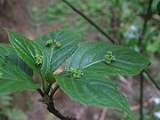
Helwingia
Encyclopedia
The genus Helwingia consists of 2-5 species
of shrub
s native to Asia
. It is the only genus in the family
Helwingiaceae.
The plants have alternate leaves
and small inflorescence
s which are epiphyllous (growing from the leaves). They are from temperate regions of eastern Asia
: for example China
, Nepal
, and Japan
.
The APG II classification (2003)
places them in the order Aquifoliales
, along with the hollies
and Phyllonomaceae
.
The family Helwingiaceae does not exist in the
Cronquist classification (1981)
, which places this genus in the Cornaceae
(dogwood family).
Species
In biology, a species is one of the basic units of biological classification and a taxonomic rank. A species is often defined as a group of organisms capable of interbreeding and producing fertile offspring. While in many cases this definition is adequate, more precise or differing measures are...
of shrub
Shrub
A shrub or bush is distinguished from a tree by its multiple stems and shorter height, usually under 5–6 m tall. A large number of plants may become either shrubs or trees, depending on the growing conditions they experience...
s native to Asia
Asia
Asia is the world's largest and most populous continent, located primarily in the eastern and northern hemispheres. It covers 8.7% of the Earth's total surface area and with approximately 3.879 billion people, it hosts 60% of the world's current human population...
. It is the only genus in the family
Family (biology)
In biological classification, family is* a taxonomic rank. Other well-known ranks are life, domain, kingdom, phylum, class, order, genus, and species, with family fitting between order and genus. As for the other well-known ranks, there is the option of an immediately lower rank, indicated by the...
Helwingiaceae.
The plants have alternate leaves
Leaf
A leaf is an organ of a vascular plant, as defined in botanical terms, and in particular in plant morphology. Foliage is a mass noun that refers to leaves as a feature of plants....
and small inflorescence
Inflorescence
An inflorescence is a group or cluster of flowers arranged on a stem that is composed of a main branch or a complicated arrangement of branches. Strictly, it is the part of the shoot of seed plants where flowers are formed and which is accordingly modified...
s which are epiphyllous (growing from the leaves). They are from temperate regions of eastern Asia
Asia
Asia is the world's largest and most populous continent, located primarily in the eastern and northern hemispheres. It covers 8.7% of the Earth's total surface area and with approximately 3.879 billion people, it hosts 60% of the world's current human population...
: for example China
China
Chinese civilization may refer to:* China for more general discussion of the country.* Chinese culture* Greater China, the transnational community of ethnic Chinese.* History of China* Sinosphere, the area historically affected by Chinese culture...
, Nepal
Nepal
Nepal , officially the Federal Democratic Republic of Nepal, is a landlocked sovereign state located in South Asia. It is located in the Himalayas and bordered to the north by the People's Republic of China, and to the south, east, and west by the Republic of India...
, and Japan
Japan
Japan is an island nation in East Asia. Located in the Pacific Ocean, it lies to the east of the Sea of Japan, China, North Korea, South Korea and Russia, stretching from the Sea of Okhotsk in the north to the East China Sea and Taiwan in the south...
.
The APG II classification (2003)
APG II system
The APG II system of plant classification is the second, now obsolete, version of a modern, mostly molecular-based, system of plant taxonomy that was published in April 2003 by the Angiosperm Phylogeny Group. It was a revision of the first APG system, published in 1998, and was superseded in 2009...
places them in the order Aquifoliales
Aquifoliales
The Aquifoliales are an order of flowering plants, including most notably the Aquifoliaceae, or holly family, and also the Helwingiaceae and the Phyllonomaceae . In 2001, the families Stemonuraceae and Cardiopteridaceae were added to this order...
, along with the hollies
Holly
Ilex) is a genus of 400 to 600 species of flowering plants in the family Aquifoliaceae, and the only living genus in that family. The species are evergreen and deciduous trees, shrubs, and climbers from tropics to temperate zones world wide....
and Phyllonomaceae
Phyllonomaceae
The family Phyllonomaceae is a family of dicotyledons, consisting of 4 species of trees and shrubs in the genus Phyllonoma. They are native to Central America ....
.
The family Helwingiaceae does not exist in the
Cronquist classification (1981)
Cronquist system
The Cronquist system is a taxonomic classification system of flowering plants. It was developed by Arthur Cronquist in his texts An Integrated System of Classification of Flowering Plants and The Evolution and Classification of Flowering Plants .Cronquist's system places flowering plants into two...
, which places this genus in the Cornaceae
Cornaceae
Cornaceae is a cosmopolitan family of flowering plants in the order Cornales. It contains approximately 110 species, mostly trees and shrubs, which may be deciduous or evergreen. Members of this family usually have opposite or alternate simple leaves, four- or five-parted flowers clustered in...
(dogwood family).
External links
- Aquifoliales - Angiosperm Phylogeny Website, consulted 2007-01-26.
- Helwingiaceae, Watson, L., and Dallwitz, M.J. 1992 onwards. The families of flowering plants: descriptions, illustrations, identification, and information retrieval. Version: 29 July 2006.
- Also see Cornaceae
- Helwingiaceae from NCBI-Taxonomy
- Helwingiaceae, USDA, ARS, National Genetic Resources Program. Germplasm Resources Information Network - (GRIN Online Database). National Germplasm Resources Laboratory, Beltsville, Maryland. Consulted 2007-01-26.

